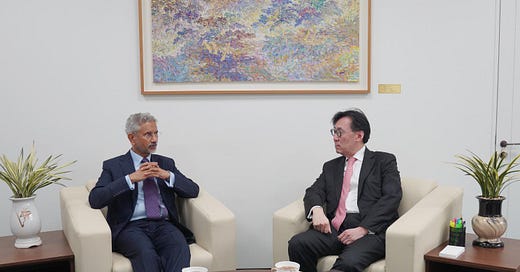Indian Minilateralism - Seoul-Tokyo-New Delhi - the Trilateral Technology Dialogue
US Envoy Garcetti: India Loves “Geometric Diplomacy”
Last week, US Ambassador to India, Eric Garcetti, said at a public event that the Quad reflected “shared interests of having a peaceful, democratic, just, open and accountable Indo-Pacific. Garcetti also commented on India’s style of diplomacy, saying that “India love[d] geometric diplomacy — triangles, squares, quadrilaterals” while also bringing light to the limits of multilateralism and bilateralism in today’s world.
In essence, Garcetti was referring to a particular brand of Indian minilateralism in an era when multilateralism at institutions like the United Nations (UN) is perceived with skepticism, amidst their failure to solve important security and geopolitical challenges like Russia’s invasion of Ukraine, or the Israel-Hamas war and its economic impact on global shipping. In the absence of multilateralism, as Dossani points out, informal arrangements like the Quad — and security minilaterals like the AUKUS — have increasingly gained traction, along with regional arrangements to solve issues related to supply chains, for instance. Minilaterals are commonly non-institutionalised groupings that have fewer participants and pursue issue-based agendas, while multilaterals are bigger groupings that are typically institutionalised, with broader mandates.
The US envoy shared the stage with the Australian High Commissioner, Philip Green, former Indian Foreign Secretary, Nirupama Rao, and British High Commissioner Alex Ellis at the India Today Conclave.
An India-South Korea-Japan trilateral, and the Trilateral Technology Dialogue
In that vein, greater New Delhi-Seoul-Tokyo trilateral cooperation has been doing the rounds. Indian Foreign Minister S. Jaishankar’s trip to East Asia led to wide-ranging discussions — separately — with Seoul and Tokyo at the 10th India-Republic of Korea Joint Commission Meeting (JCM) and the 16th India-Japan Foreign Ministers Strategic Dialogue. Bilateral relations with both Japan and South Korea have been deepening in recent times; with the former, recent attention has been devoted to deepening cooperation areas like connectivity, defence, and critical technologies and infrastructure. As our previous edition noted, Komikawa and Jaishankar’s discussions regarding expanding the India-Japan global and strategic partnership focused on trade, investment, infrastructure and technology collaboration, developmental coordination, defence and security cooperation, as well as cultural and people-to-people exchanges.
Both India and Japan have set the target of achieving a 5 trillion yen ($33.21 billion) investment from Japan by 2027, which would require an increase in investment from Japanese companies. For instance, the number of Japanese companies doing business in India stood at 1400 (as of 2022), whereas those in China stood at 13,700 (in 2019). Perhaps this led Jaishankar to flag that Japanese firms were “overly cautious” and urged them to invest more aggressively.
Meanwhile, Jaishankar’s discussions with his South Korean counterpart, Cho Tae-yul, focused on expanding the strategic relationship to critical and emerging technologies, semiconductors, and green hydrogen.
In this vein, Pant writes of a potential institutional trilateral in the making between South Korea, India, and Japan. For India, both countries play important roles in India’s Indo-Pacific outreach and contribute significantly to the region’s strategic landscape across various dimensions.
Economic collaboration with South Korea, driven by its advanced technological capabilities, contributes significantly to India’s economic and technological advancements in the Indo-Pacific…a more cohesive and cooperative East Asia translates into a more conducive environment for India
The Trilateral Technology Dialogue (TTD) made headlines last week, a dialogue between the United States, South Korea, and India. Here is my colleague Saurabh Todi’s contribution to Takshashila’s Technopolitik newsletter, analysing what the dialogue was all about, and potential directions the trilateral may take in the future:
—
The Trilateral Technology Dialogue (TTD) convened by the United States, South Korea, and India on March 13, 2024, marked a significant step towards expanding regional cooperation on critical and emerging technologies. The dialogue aims to foster innovation, bolster economic growth, and enhance technology supply chain resilience in the Indo-Pacific region. It underscored the preference for multilateral initiatives among regional countries amid escalating great power competition, particularly with China. Geopolitical tensions and economic vulnerabilities have prompted nations to implement supply chain resilience measures like friend-shoring, derisking, and decoupling.
Bilateral initiatives between the US, South Korea, and India, such as the US-ROK Next Generational Critical and Emerging Technology Dialogue and the US-India Initiative on Critical and Emerging Technology, reflect shared concerns over technological vulnerabilities. The TTD aims to bolster cooperation across various technological domains, including semiconductors, telecommunications, artificial intelligence, quantum computing, defence, and biotechnology.
While ambitious, the TTD's scope necessitates prioritising sectors with existing synergies, such as semiconductor production and green technologies like hydrogen and small modular reactors (SMRs). The dialogue could facilitate collaboration in areas where each country has a competitive advantage, thereby mitigating supply chain risks and advancing common goals like achieving net-zero emissions.
However, potential cooperation faces challenges, including geopolitical shifts and evolving trade policies. Political dynamics, particularly in the US, can impact trade relations and multilateral initiatives. For instance, South Korea's trade surplus with the US may provoke a political backlash, necessitating careful navigation of trade discussions. India also grapples with trade deficits, particularly with South Korea, prompting a renegotiation of its FTA with South Korea to address concerns.
Despite challenges, the TTD represents a crucial step towards enhancing regional security, stability, and prosperity. It underscores the importance of sustained cooperation to achieve tangible outcomes amidst geopolitical complexities and economic uncertainties. Efforts to navigate trade dynamics and leverage technological synergies are vital for realising the full potential of trilateral collaboration in the Indo-Pacific.
What we’re reading this week
A piece in the Australian Strategic Policy Institute’s The Strategist, focusing on the Quad’s efforts to promote supply chain resilience in the telecommunications sector, by Bharath Reddy
A piece in The Statesman analysing India’s relations with Japan and South Korea, by Rajaram Panda
A piece in the South China Morning Post, arguing how Australia and Japan can help ASEAN leverage Australian and the Quad’s resources to manage the more assertive aspects of China’s regional behaviour, by William Choong and Sharon Seah
If you like reading this weekly newsletter, please subscribe!






